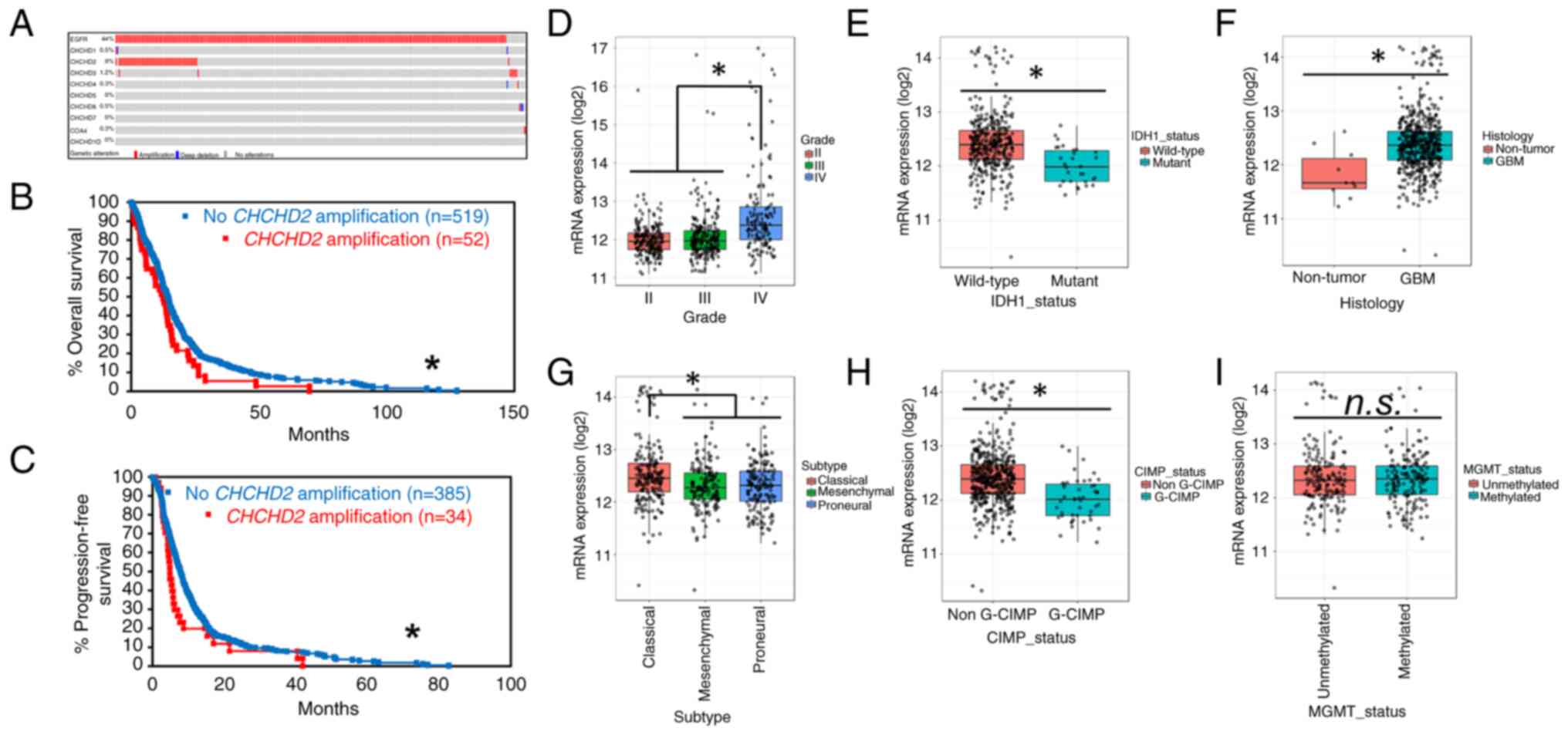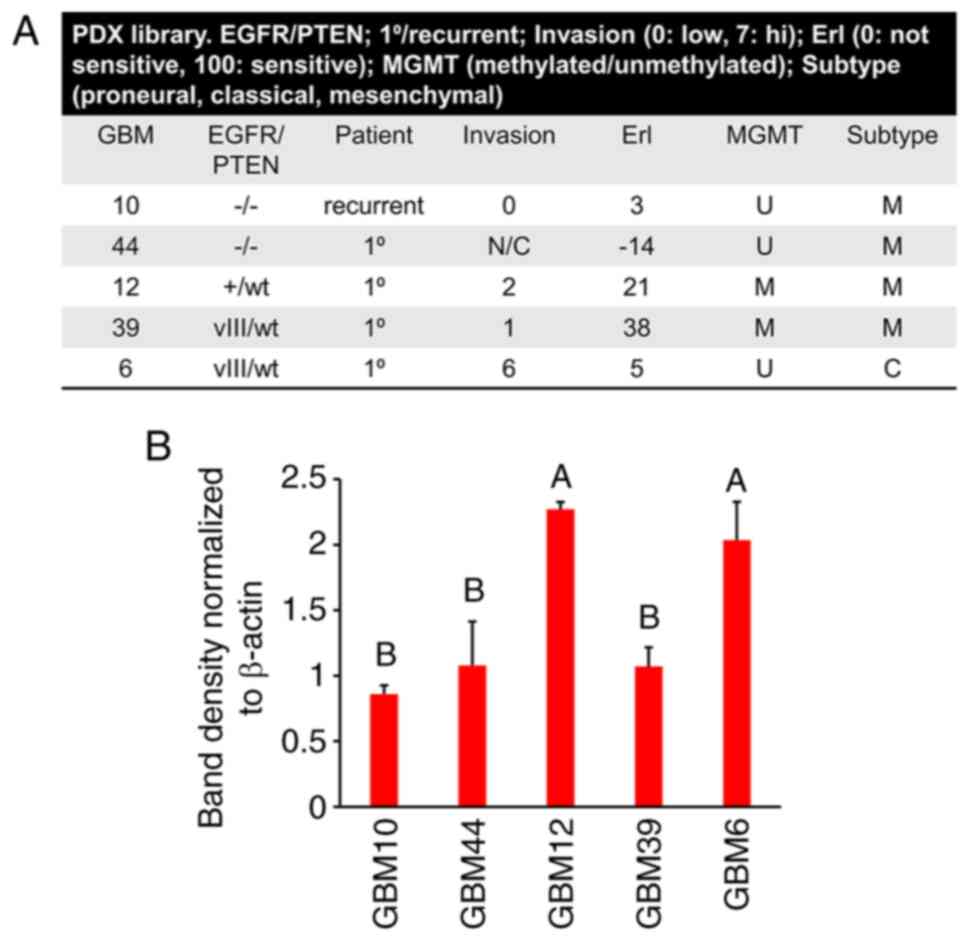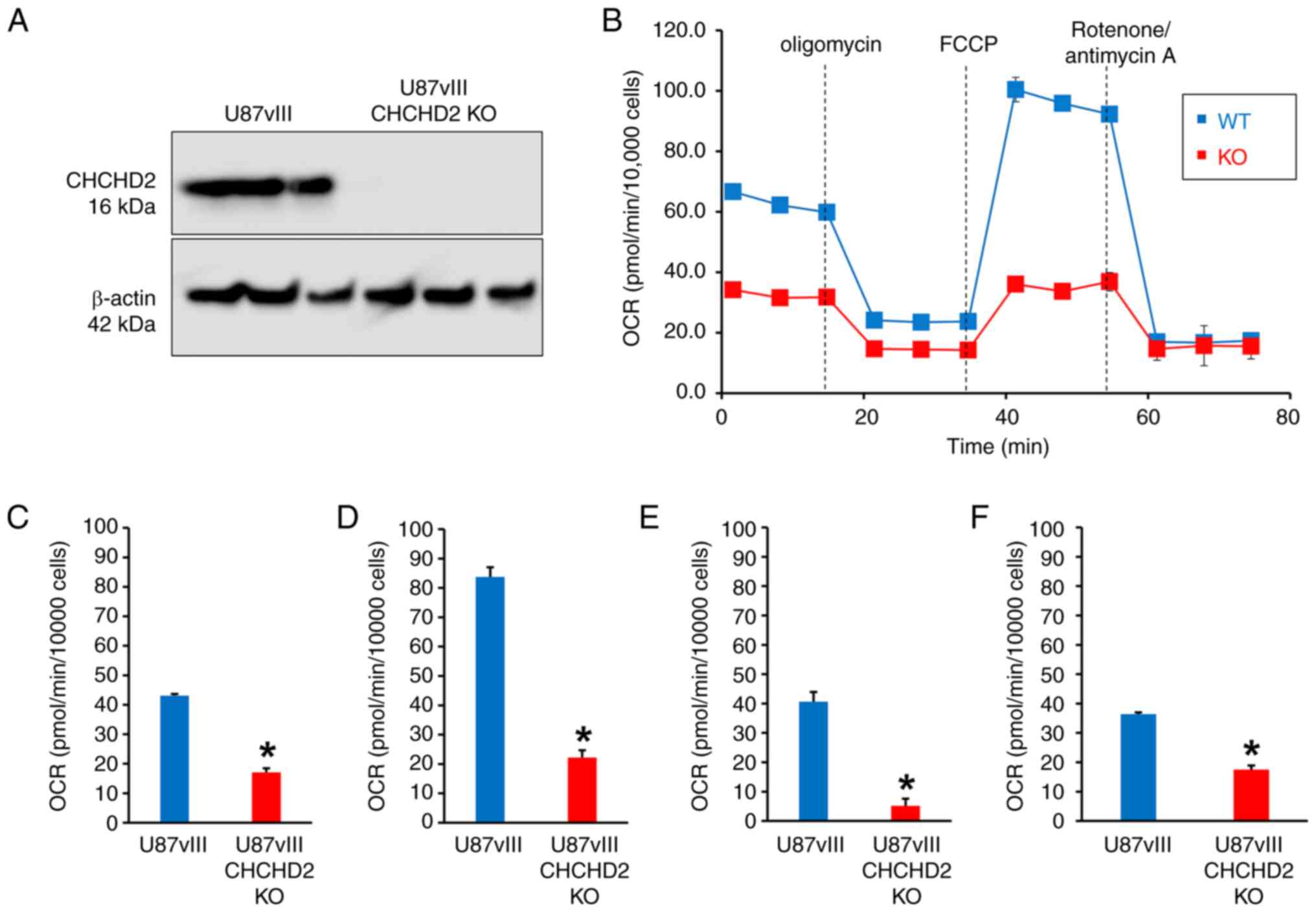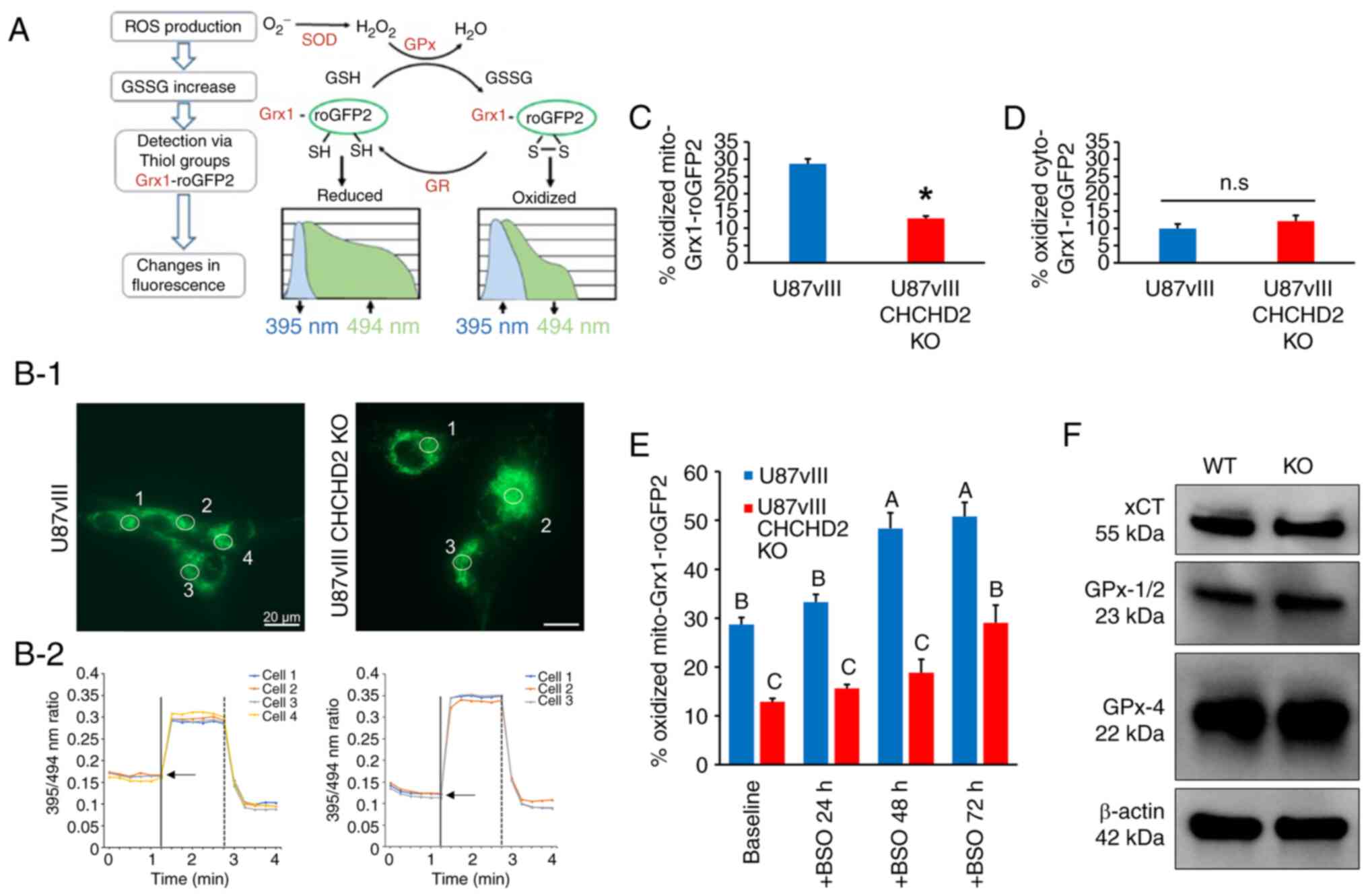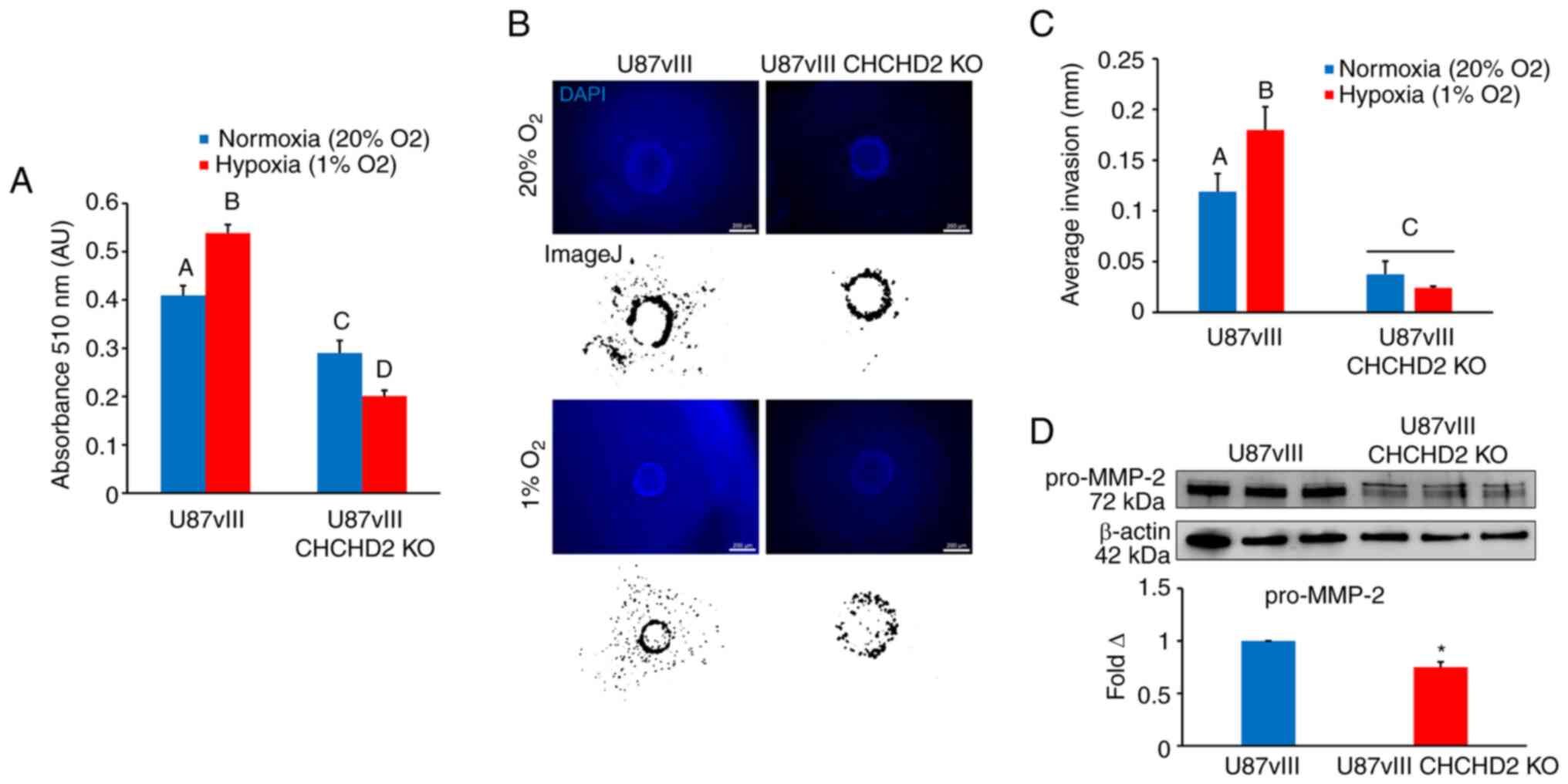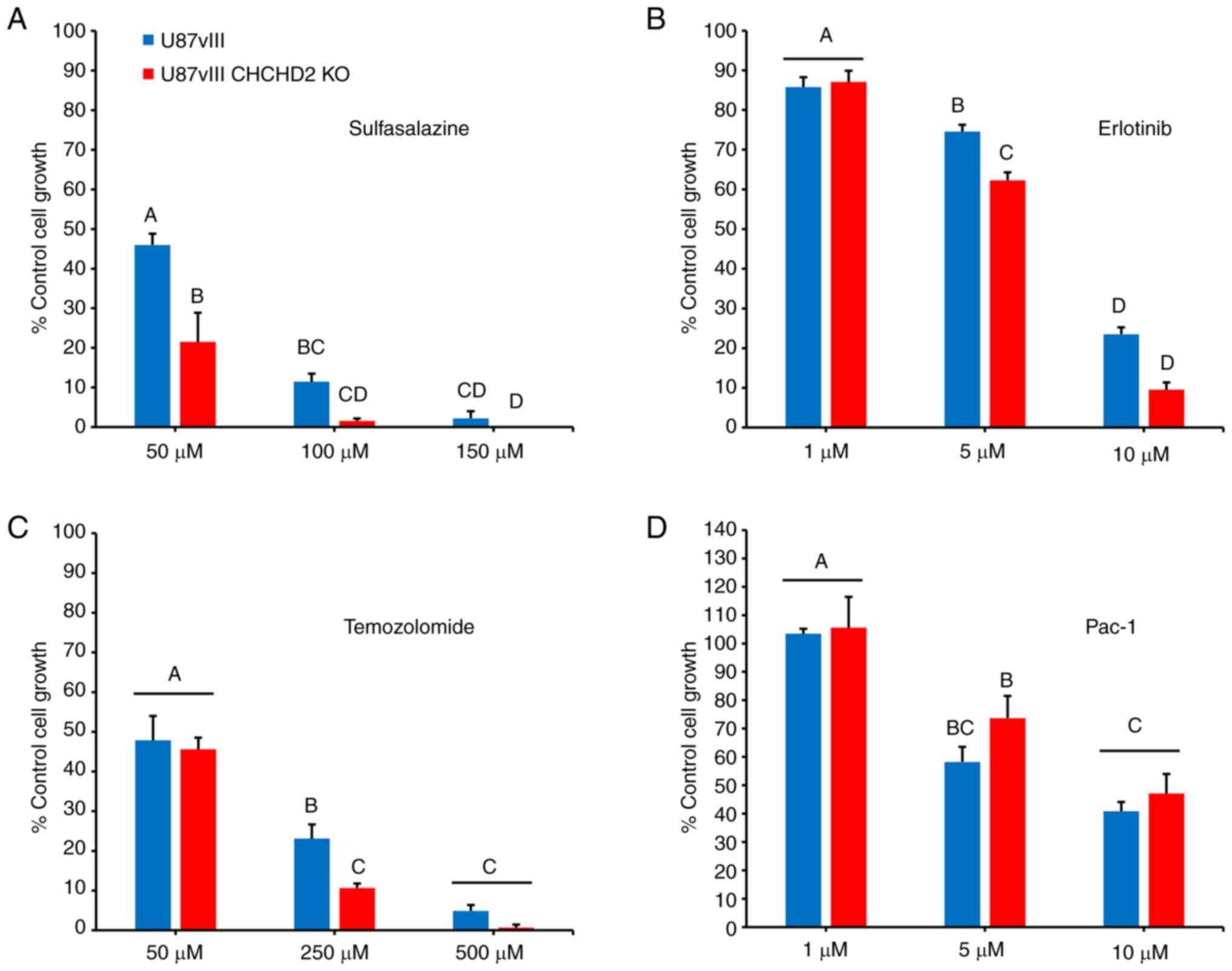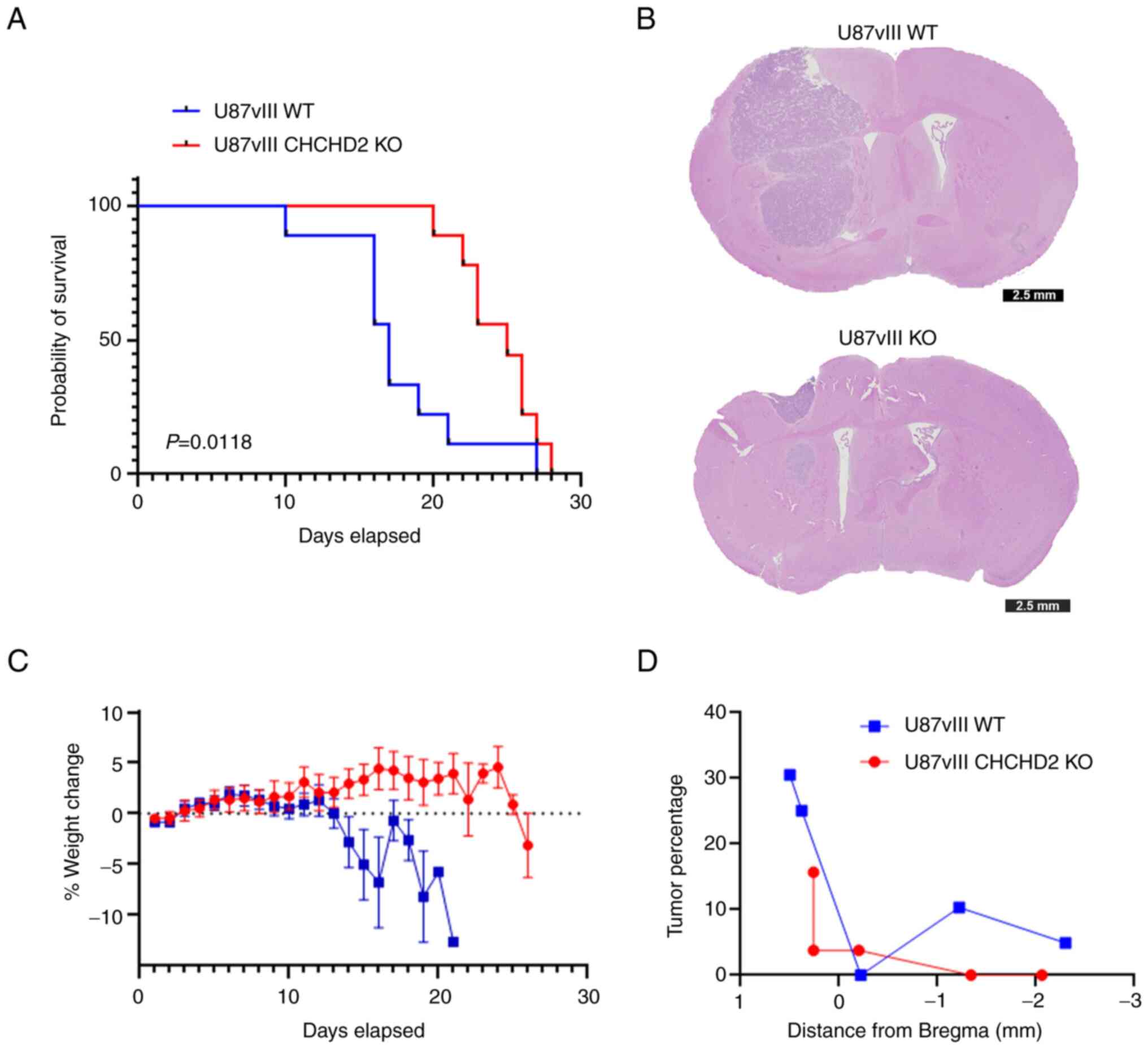|
1
|
Barnholtz-Sloan JS, Ostrom QT and Cote D:
Epidemiology of brain tumors. Neurol Clin. 36:395–419. 2018.
View Article : Google Scholar : PubMed/NCBI
|
|
2
|
Stupp R, Taillibert S, Kanner A, Read W,
Steinberg D, Lhermitte B, Toms S, Idbaih A, Ahluwalia MS, Fink K,
et al: Effect of tumor-treating fields plus maintenance
temozolomide vs maintenance temozolomide alone on survival in
patients with glioblastoma: A randomized clinical trial. JAMA.
318:2306–2316. 2017. View Article : Google Scholar : PubMed/NCBI
|
|
3
|
Omuro A and DeAngelis LM: Glioblastoma and
other malignant gliomas: A clinical review. JAMA. 310:1842–1850.
2013. View Article : Google Scholar : PubMed/NCBI
|
|
4
|
Ceccarelli M, Barthel FP, Malta TM,
Sabedot TS, Salama SR, Murray BA, Morozova O, Newton Y, Radenbaugh
A, Pagnotta SM, et al: Molecular profiling reveals biologically
discrete subsets and pathways of progression in diffuse glioma.
Cell. 164:550–563. 2016. View Article : Google Scholar : PubMed/NCBI
|
|
5
|
Weller M, Butowski N, Tran DD, Recht LD,
Lim M, Hirte H, Ashby L, Mechtler L, Goldlust SA, Iwamoto F, et al:
Rindopepimut with temozolomide for patients with newly diagnosed,
EGFRvIII-expressing glioblastoma (ACT IV): A randomised,
double-blind, international phase 3 trial. Lancet Oncol.
18:1373–1385. 2017. View Article : Google Scholar
|
|
6
|
Gan HK, Kaye AH and Luwor RB: The EGFRvIII
variant in glioblastoma multiforme. J Clin Neurosci. 16:748–754.
2009. View Article : Google Scholar : PubMed/NCBI
|
|
7
|
Parker JJ, Canoll P, Niswander L,
Kleinschmidt-DeMasters BK, Foshay K and Waziri A: Intratumoral
heterogeneity of endogenous tumor cell invasive behavior in human
glioblastoma. Sci Rep. 8:180022018. View Article : Google Scholar :
|
|
8
|
Raizer JJ, Abrey LE, Lassman AB, Chang SM,
Lamborn KR, Kuhn JG, Yung WK, Gilbert MR, Aldape KA, Wen PY, et al:
A phase II trial of erlotinib in patients with recurrent malignant
gliomas and nonprogressive glioblastoma multiforme postradiation
therapy. Neuro Oncol. 12:95–103. 2010. View Article : Google Scholar : PubMed/NCBI
|
|
9
|
Raizer JJ, Giglio P, Hu J, Groves M,
Merrell R, Conrad C, Phuphanich S, Puduvalli VK, Loghin M,
Paleologos N, et al: A phase II study of bevacizumab and erlotinib
after radiation and temozolomide in MGMT unmethylated GBM patients.
J Neurooncol. 126:185–192. 2016. View Article : Google Scholar :
|
|
10
|
Wei Y, Vellanki R, Coyaud É, Ignatchenko
V, Li L, Krieger J, Taylor P, Tong J, Pham NA, Liu G, et al: CHCHD2
is coamplified with EGFR in NSCLC and regulates mitochondrial
function and cell migration. Mol Cancer Res. 13:1119–1129. 2015.
View Article : Google Scholar : PubMed/NCBI
|
|
11
|
Cheng Q, Qu D, Lu Z and Zhang L: Knockdown
of CHCHD2 inhibits migration and angiogenesis of human renal cell
carcinoma: A potential molecular marker for treatment of RCC. Oncol
Lett. 17:765–772. 2019.PubMed/NCBI
|
|
12
|
Aras S, Maroun MC, Song Y, Bandyopadhyay
S, Stark A, Yang Z, Long MP, Grossman LI and Fernández-Madrid F:
Mitochondrial autoimmunity and MNRR1 in breast carcinogenesis. BMC
Cancer. 19:4112019. View Article : Google Scholar : PubMed/NCBI
|
|
13
|
Modjtahedi N, Tokatlidis K, Dessen P and
Kroemer G: Mitochondrial proteins containing
Coiled-Coil-Helix-Coiled-Co il-Helix (CHCH) domains in health and
disease. Trends Biochem Sci. 41:245–260. 2016. View Article : Google Scholar : PubMed/NCBI
|
|
14
|
Zhou ZD, Saw WT and Tan EK: Mitochondrial
CHCHD-containing proteins: Physiologic functions and link with
neurodegenerative diseases. Mol Neurobiol. 5:5547–5549. 2017.
View Article : Google Scholar
|
|
15
|
Aras S, Bai M, Lee I, Springett R,
Hüttemann M and Grossman LI: MNRR1 (formerly CHCHD2) is a
bi-organellar regulator of mitochondrial metabolism. Mitochondrion.
20:43–51. 2015. View Article : Google Scholar
|
|
16
|
Baughman JM, Nilsson R, Gohil VM, Arlow
DH, Gauhar Z and Mootha VK: A computational screen for regulators
of oxidative phosphorylation implicates SLIRP in mitochondrial RNA
homeostasis. PLoS Genet. 5:e10005902009. View Article : Google Scholar :
|
|
17
|
Meng H, Yamashita C, Shuba-Fukushima K,
Inoshita T, Funayama M, Sato S, Hatta T, Natsume T, Umitsu M,
Takagi J, et al: Loss of Parkinson's disease-associated protein
CHCHD2 affects mitochondrial crista structure and destabilizes
cytochrome c. Nat Commun. 8:155002017. View Article : Google Scholar : PubMed/NCBI
|
|
18
|
Seo M, Lee WH and Suk K: Identification of
novel cell migration-promoting genes by a functional genetic
screen. FASEB J. 24:464–478. 2010. View Article : Google Scholar
|
|
19
|
Liu Y, Clegg HV, Leslie PL, Di J, Tollini
LA, He Y, Kim TH, Jin A, Graves LM, Zheng J and Zhang Y: CHCHD2
inhibits apoptosis by interacting with Bcl-x L to regulate Bax
activation. Cell Death Differ. 22:1035–1046. 2015. View Article : Google Scholar :
|
|
20
|
Aras S, Pak O, Sommer N, Finley R Jr,
Hüttemann M, Weissmann N and Grossman LI: Oxygen-dependent
expression of cytochrome c oxidase subunit 4-2 gene expression is
mediated by transcription factors RBPJ, CXXC5 and CHCHD2. Nucleic
Acids Res. 41:2255–2266. 2013. View Article : Google Scholar
|
|
21
|
Cerami E, Gao J, Dogrusoz U, Gross BE,
Sumer SO, Aksoy BA, Jacobsen A, Byrne CJ, Heuer ML, Larsson E, et
al: The cBio cancer genomics portal: An open platform for exploring
multidimensional cancer genomics data. Cancer Discov. 2:401–404.
2012. View Article : Google Scholar
|
|
22
|
Gao J, Aksoy BA, Dogrusoz U, Dresdner G,
Gross B, Sumer SO, Sun Y, Jacobsen A, Sinha R, Larsson E, et al:
Integrative analysis of complex cancer genomics and clinical
profiles using the cBioPortal. Sci Signal. 6:p112013. View Article : Google Scholar
|
|
23
|
Bowman RL, Wang Q, Carro A, Verhaak RGW
and Squatrito M: GlioVis data portal for visualization and analysis
of brain tumor expression datasets. Neuro Oncol. 19:139–141. 2017.
View Article : Google Scholar
|
|
24
|
Sarkaria JN, Carlson BL, Schroeder MA,
Grogan P, Brown PD, Giannini C, Ballman KV, Kitange GJ, Guha A,
Pandita A and James CD: Use of an orthotopic xenograft model for
assessing the effect of epidermal growth factor receptor
amplification on glioblastoma radiation response. Clin Cancer Res.
12:2264–2271. 2006. View Article : Google Scholar : PubMed/NCBI
|
|
25
|
Sarkaria JN, Yang L, Grogan PT, Kitange
GJ, Carlson BL, Schroeder MA, Galanis E, Giannini C, Wu W, Dinca EB
and James CD: Identification of molecular characteristics
correlated with glioblastoma sensitivity to EGFR kinase inhibition
through use of an intracranial xenograft test panel. Mol Cancer
Ther. 6:1167–1674. 2007. View Article : Google Scholar : PubMed/NCBI
|
|
26
|
Vaubel RA, Tian S, Remonde D, Schroeder
MA, Mladek AC, Kitange GJ, Caron A, Kollmeyer TM, Grove R, Peng S,
et al: Genomic and phenotypic characterization of a broad panel of
patient-derived xenografts reflects the diversity of glioblastoma.
Clin Cancer Res. 26:1094–1104. 2020. View Article : Google Scholar
|
|
27
|
Hüttemann M, Lee I, Liu J and Grossman LI
and Grossman LI: Transcription of mammalian cytochrome c oxidase
subunit IV-2 is controlled by a novel conserved oxygen responsive
element. FEBS J. 274:5737–5748. 2007. View Article : Google Scholar : PubMed/NCBI
|
|
28
|
Ran FA, Hsu PD, Wright J, Agarwala V,
Scott DA and Zhang F: Genome engineering using the CRISPR-Cas9
system. Nat Protoc. 8:2281–2308. 2013. View Article : Google Scholar : PubMed/NCBI
|
|
29
|
Wong N, Liu W and Wang X: WU-CRISPR:
Characteristics of functional guide RNAs for the CRISPR/Cas9
system. Genome Biol. 16:2182015. View Article : Google Scholar : PubMed/NCBI
|
|
30
|
Kolossov VL, Beaudoin JN, Ponnuraj N,
DiLiberto S, Hanafin WP, Kenis PJA and Gaskins HR: Thiol-based
antioxidants elicit mitochondrial oxidation via respiratory complex
III. Am J Physiol Cell Physiol. 309:C81–C91. 2015. View Article : Google Scholar : PubMed/NCBI
|
|
31
|
Vichai V and Kirtikara K: Sulforhodamine B
colorimetric assay for cytotoxicity screening. Nat Protoc.
1:1112–1116. 2006. View Article : Google Scholar
|
|
32
|
Joshi AD, Botham RC, Schlein LJ, Roth HS,
Mangraviti A, Borodovsky A, Tyler B, Joslyn S, Looper JS, Podell M,
et al: Synergistic and targeted therapy with a procaspase-3
activator and temozolomide extends survival in glioma rodent models
and is feasible for the treatment of canine malignant glioma
patients. Oncotarget. 8:80124–80138. 2017. View Article : Google Scholar : PubMed/NCBI
|
|
33
|
Chen JE, Lumibao J, Blazek A, Gaskins HR
and Harley B: Hypoxia activates enhanced invasive potential and
endogenous hyaluronic acid production by glioblastoma cells.
Biomater Sci. 6:854–862. 2018. View Article : Google Scholar : PubMed/NCBI
|
|
34
|
Chen JE, Pedrons S and Harley BAC: The
combined influence of hydrogel stiffness and matrix-bound
hyaluronic acid content on glioblastoma invasion. Macromol Biosci.
17: View Article : Google Scholar : 2017.
|
|
35
|
Chen JE, Pedron S, Shyu P, Hu Y, Sarkaria
JN and Harley BAC: Influence of hyaluronic acid transitions in
tumor microenvironment on glioblastoma malignancy and invasive
hehavior. Front Mater. 5:392018. View Article : Google Scholar
|
|
36
|
Brennan CW, Verhaak RG, McKenna A, Campos
B, Noushmehr H, Salama SR, Zheng S, Chakravarty D, Sanborn JZ,
Berman SH, et al: The somatic genomic landscape of glioblastoma.
Cell. 155:462–477. 2013. View Article : Google Scholar : PubMed/NCBI
|
|
37
|
Divakaruni AS, Paradyse A, Ferrick DA,
Murphy AN and Jastroch M: Analysis and interpretation of
microplate-based oxygen consumption and pH data. Methods Enzymol.
547:309–354. 2014. View Article : Google Scholar
|
|
38
|
Hanschmann EM, Godoy JR, Berndt C,
Hudemann C and Lillig CH: Thioredoxins, glutaredoxins, and
peroxiredoxins-molecular mechanisms and health significance: From
cofactors to antioxidants to redox signaling. Antioxid Redox
Signal. 19:1539–1605. 2013. View Article : Google Scholar : PubMed/NCBI
|
|
39
|
Estrela JM, Ortega A and Obrador E:
Glutathione in cancer biology and therapy. Crit Rev Clin Lab Sci.
43:143–181. 2006. View Article : Google Scholar : PubMed/NCBI
|
|
40
|
Stupp R, Mason WP, van den Bent MJ, Weller
M, Fisher B, Taphoorn MJB, Belanger K, Brandes AA, Marosi C,
Bogdahn U, et al: Radiotherapy plus concomitant and adjuvant
temozolomide for glioblastoma. N Engl J Med. 352:987–996. 2005.
View Article : Google Scholar : PubMed/NCBI
|
|
41
|
Chen L, Li X, Liu L, Yu B, Xue Y and Liu
Y: Erastin sensitizes glioblastoma cells to temozolomide by
restraining xCT and cystathionine-γ-lyase function. Oncol Rep.
33:1465–1474. 2015. View Article : Google Scholar : PubMed/NCBI
|
|
42
|
Huberfeld G and Vecht CJ: Seizures and
gliomas-towards a single therapeutic approach. Nat Rev Neurol.
12:204–216. 2016. View Article : Google Scholar : PubMed/NCBI
|
|
43
|
Eisenberg-Bord M and Schuldiner M: Ground
control to major TOM: Mitochondria-nucleus communication. FEBS J.
284:196–210. 2017. View Article : Google Scholar
|
|
44
|
Yogev O, Naamati A and Pines O: Fumarase:
A paradigm of dual targeting and dual localized functions. FEBS J.
278:4230–4242. 2011. View Article : Google Scholar : PubMed/NCBI
|
|
45
|
Zhuang J, Wang PY, Huang X, Chen X, Kang
JG and Hwang PM: Mitochondrial disulfide relay mediates
translocation of p53 and partitions its subcellular activity. Proc
Natl Acad Sci USA. 110:17356–17361. 2013. View Article : Google Scholar : PubMed/NCBI
|
|
46
|
Sutendra G, Kinnaird A, Dromparis P,
Paulin R, Stenson TH, Haromy A, Hashimoto K, Zhang N, Flaim E and
Michelakis ED: A nuclear pyruvate dehydrogenase complex is
important for the generation of acetyl-CoA and histone acetylation.
Cell. 158:84–97. 2014. View Article : Google Scholar : PubMed/NCBI
|
|
47
|
Courtney KD, Bezwada D, Mashimo T,
Pichumani K, Vemireddy V, Funk AM, Wimberly J, McNeil SS, Kapur P,
Lotan Y, et al: Isotope tracing of human clear cell renal cell
carcinomas demonstrates suppressed glucose oxidation in vivo. Cell
Metab. 28:793–800.e2. 2018. View Article : Google Scholar :
|
|
48
|
Marin-Valencia I, Yang C, Mashimo T, Cho
S, Baek H, Yang XI, Rajagopalan KN, Maddie M, Vemireddy V, Zhao Z,
et al: Analysis of tumor metabolism reveals mitochondrial glucose
oxidation in genetically diverse human glioblastomas in the mouse
brain in vivo. Cell Metab. 15:827–237. 2012. View Article : Google Scholar : PubMed/NCBI
|
|
49
|
Pavlova NN and Thompson CB: The emerging
hallmarks of cancer metabolism. Cell Metab. 23:27–47. 2016.
View Article : Google Scholar : PubMed/NCBI
|
|
50
|
Vlashi E, Lagadec C, Vergnes L, Matsutani
T, Masui K, Poulou M, Popescu R, Della Donna L, Evers P, Dekmezian
C, et al: Metabolic state of glioma stem cells and nontumorigenic
cells. Proc Natl Acad Sci USA. 108:16062–16067. 2011. View Article : Google Scholar : PubMed/NCBI
|
|
51
|
Zanotelli MR, Goldblatt ZE, Miller JP,
Bordeleau F, Li J, VanderBurgh JA, Lampi MC, King MR and
Reinhart-King CA: Regulation of ATP utilization during metastatic
cell migration by collagen architecture. Mol Biol Cell. 29:1–9.
2018. View Article : Google Scholar :
|
|
52
|
Xie Q, Wu Q, Kim L, Miller TE, Liau BB,
Mack SC, Yang K, Factor DC, Fang X, Huang Z, et al: RBPJ maintains
brain tumor-initiating cells through CDK9-mediated transcriptional
elongation. J Clin Invest. 126:2757–2772. 2016. View Article : Google Scholar :
|



